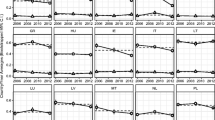Abstract
This study analyses the role of immigration background and education in creating new business initiatives in Luxembourg, a country where 44 % of the resident population is immigrant. We investigate the features of entrepreneurs and of the Luxembourgish System of Entrepreneurship using the Global Entrepreneurship Monitoring surveys of 2013 and 2014. We study the effect of immigration through all the stages of entrepreneurial process: interest in starting a new business, effectively starting, running a new business and managing an established business. We adopt a sequential logit to model entrepreneurial process as a sequence of stages. We find that first-generation immigrants, and in particular highly educated ones, are more interested in starting a new business than non-immigrants, but they do not differ in subsequent entrepreneurial phases. We argue that policies to attract highly educated immigrants can promote entrepreneurial initiatives in Luxembourg.




Similar content being viewed by others
Notes
Ethnic enclaves can be defined as self-contained minority communities nested in metropolitan areas (Wilson and Martin 1982).
In a well-known study, Wilson and Portes (1980) found that Cuban immigrants working for Cuban employers in Miami experienced significant returns to their human capital.
Luxembourg en chiffres, STATEC, 2014 can be found on: http://www.statistiques.public.lu/en/publications/series/lux-figures/index.html.
On labour force statistics in Luxembourg, one can see data and publications on STATEC’s website, in particular http://www.statistiques.public.lu/en/population-employment/index.html. One can also see the various issues of the Rapport travail et cohésion sociale, published regularly by STATEC.
In six other European countries—namely, Cyprus, Austria, Germany, Great Britain, Ireland and Belgium—people with an immigration background will account for more than 30 % of the resident population.
For example, questionnaire provides information about the sector of economic activity only after the starting of the new venture. Therefore, only the last two phases include these controls.
Model estimates are available upon request from the authors.
References
Acs, Z., Autio, E., & Szerb, L. (2014). National systems of entrepreneurship: Measurement issues and policy implications. Research Policy, 43(3), 476–494. doi:10.2139/ssrn.2008160.
Aldrich, H. E., & Waldinger, R. (1990). Ethnicity and entrepreneurship. Annual Review of Sociology, 16(1), 111–135. doi:10.1146/annurev.so.16.080190.000551.
Algan, Y., & Cahuc, P. (2010). Inherited trust and growth. The American Economic Review, 100(5), 2060–2092. doi:10.1257/aer.100.5.2060.
Aliaga-Isla, R., & Rialp, A. (2013). Systematic review of immigrant entrepreneurship literature: Previous findings and ways forward. Entrepreneurship & Regional Development, 25(9–10), 819–844. doi:10.1080/08985626.2013.845694.
Altinay, L. (2008). The relationship between an entrepreneur’s culture and the entrepreneurial behaviour of the firm. Journal of Small Business and Enterprise Development, 15(1), 111–129. doi:10.1108/14626000810850874.
Alvarez, C., Urbano, D., & Amoras, J. (2014). GEM research: Achievements and challenges. Small Business Economics, 42(3), 445–465. doi:10.1007/s11187-013-9517-5.
Amoros, J., & Bosma, N. (2014). Global Entrepreneurship Monitor global report 2013.
Audretsch, D. B. (2007). Entrepreneurship capital and economic growth. Oxford Review of Economic Policy, 23, 63–78. doi:10.4337/9781783476923.00011.
Auster, E., & Aldrich, H. (1984). Small business vulnerability, ethnic enclaves and ethnic enterprise. In R. J. Robin Ward (Ed.), Ethnic communities in business: Strategies for economic survival (Chap. 3, pp. 39–54). Cambridge, NY: Cambridge University Press.
Barone, C. (2009). Occupational promotion of migrant workers. http://www.eurofound.europa.eu/ewco/studies/tn0807038s/tn0807038s.htm.
Basu, A., & Altinay, E. (2002). The interaction between culture and entrepreneurship in London’s immigrant businesses. International Small Business Journal, 20(4), 371–393. doi:10.1177/0266242602204001.
Batista, C., & Umblijs, J. (2014). Migration, risk attitudes, and entrepreneurship. IZA Journal of Migration. doi:10.1186/s40176-014-0017-4.
Bonacich, E. (1993). The other side of ethnic entrepreneurship: A dialogue with Waldinger, Aldrich, Ward and associates. International Migration Review, 27(3), 685–692. doi:10.2307/2547120.
Borjas, G. (1986). The self-employment experience of immigrants. The Journal of Human Resources, 21(4), 485–506. doi:10.2307/145764.
Braunerhjelm, P., Acs, Z., Audretsch, D., & Carlsson, B. (2010). The missing link: Knowledge diffusion and entrepreneurship in endogenous growth. Small Business Economics, 34(2), 105–125. doi:10.1007/s11187-009-9235-1.
Buis, M. (2010). Chapter 6, not all transitions are equal: The relationship between inequality of educational opportunities and inequality of educational outcomes. In M. L. Buis (Ed.), Inequality of educational outcome and inequality of educational opportunity in the Netherlands during the 20th century. Ph.D. thesis. http://www.maartenbuis.nl/dissertation/chap_6.
Callens, M. S., Valentova, M., & Meuleman, B. (2014). Do attitudes towards the integration of immigrants change over time? A comparative study of natives, second-generation immigrants and foreign-born residents in Luxembourg. Journal of International Migration and Integration, 15(1), 135–157. doi:10.1007/s12134-013-0272-x.
Chrysostome, E. (2010). The success factors of necessity immigrant entrepreneurs: In search of a model. Thunderbird International Business Review, 52(2), 137–152. doi:10.1002/tie.20320.
Clark, K., & Drinkwater, S. (2000). Pushed out or pulled in? Self-employment among ethnic minorities in England and Wales. Labour Economics, 7(5), 603–628. doi:10.1016/s0927-5371(00)00015-4.
Coate, S., & Tennyson, S. (1992). Labor market discrimination, imperfect information and self employment. Oxford Economic Papers, 44(2), 272–288. doi:10.2307/2663369.
Constant, A., & Zimmermann, K. (2006). The making of entrepreneurs in Germany: Are native men and immigrant alike? Small Business Economics, 42(3), 279–300. doi:10.1007/s11187-005-3004-6.
Desiderio, M., & Salt, J. (2010). Main findings of the conference on entrepreneurship and employment creation of immigrants in OECD countries. Paris: OECD.
EUROSTAT. (2008). Eurostat indicators of high-tech industry and knowledge-intensive services, Annex 3.
Fregetto, E. (2004). Immigrant and ethnic entrepreneurship: A U.S. perspective. In H. Welsch (Ed.), Entrepreneurship: The way ahead (pp. 253–268). New York: Routledge. doi:10.4324/9780203356821.ch18.
Hofstede, G. (2007). Asian management in the 21st century. Asia Pacific Journal of Management, 24(4), 411–420. doi:10.1007/s10490-007-9049-0.
Hohn, M., Atkins, L., & Waslin, M. (2012). Immigrant entrepreneurs. Creating jobs and strengthening the economy. Labor, Immigration and Employee Benefits Division of the US Chamber of Commerce; Immigration Policy Center of the American Immigration Council.
Hunt, J., & Gauthier-Loiselle, M. (2010). How much does immigration boost innovation? American Economic Journal: Macroeconomics, 2(2), 31–56. doi:10.1257/mac.2.2.31.
Irastorza, N., & Pena, I. (2007). Entrepreneurial activity of immigrants versus natives in Spain: Are immigrants more enterprising than natives? Frontiers of Entrepreneurship Research, 27(9), 2.
Jean, S., Causa, O., Jimenez, M., & Wanner, I. (2007). Migration in OECD countries: Labour market impact and integration issues, OECD working paper No. 562.
Kerr, S. P., Kerr, W. R., & Lincoln, W. F. (2013). Skilled immigration and the employment structures of U.S. firms. NBER Working Papers 19658, National Bureau of Economic Research, Inc. doi:10.3386/w19658. http://ideas.repec.org/p/nbr/nberwo/19658.html.
Kloosterman, R. (2010). Matching opportunities with resources. A framework for analysing migrant entrepreneurship from a mixed embeddedness perspective. Entrepreneurship and Regional Development, 22(1), 25–45. doi:10.1080/08985620903220488.
Kloosterman, R., & Rath, J. (2001). Immigrant entrepreneurs in advanced economies: Mixed embeddedness further explored. Journal of Ethnic and Migration Studies, 27(2), 189–201. doi:10.1080/13691830020041561.
Lanzieri, G. (2011). Fewer, older and multicultural? Projections of the EU populations by foreign/national background. EUROSTAT Methodologies and Working Papers (12). doi:10.2785/17529. http://ec.europa.eu/eurostat/documents/3888793/5850217/KS-RA-11-019-EN.PDF/0345b180-b869-4cb0-907b-d755b699a369.
Li, W. (1998). Anatomy of a new ethnic settlement: The Chinese ethnoburb in Los Angeles. Urban Studies, 35(3), 479–501. doi:10.1080/0042098984871.
Light, I. (1979). Disadvantaged minorities in self-employment. International Journal of Comparative Sociology, 20(1–2), 31–45. doi:10.1177/002071527902000103.
Light, I., Sabagh, G., Bozorgmehr, M., & Der-Marirosian, C. (1994). Beyond the ethnic enclave economy. Social Problems, 41(1), 65–80. doi:10.2307/3096842.
Light, I. H., & Rosenstein, C. N. (1995). Race, ethnicity, and entrepreneurship in urban America. New York: Transaction Publishers.
Masurel, E., Nijkamp, P., & Vindigni, G. (2004). Breeding places for ethnic entrepreneurs: A comparative marketing approach. Entrepreneurship & Regional Development, 16(1), 77–86. doi:10.1080/0898562042000205045.
Nestorowicz, J. (2012). Immigrant self-employment: Definitions, concepts and methods. Central and Eastern European Migration Review, 1(1), 37–55.
OECD. (2010). Entrepreneurship and migrants, report by the OECD working party on SMEs and entrepreneurship.
Parker, S. C. (2004). The economics of self-employment and entrepreneurship. Cambridge: Cambridge University Press.
Paulson, A., & Townsend, R. (2005). Financial constraints and entrepreneurship: Evidence from the Thai financial crisis. Economic Perspectives, Federal Reserve Bank of Chicago, 29(3), 34–48.
Peri, G. (2012). The effect of immigration on productivity: Evidence from United States. Review of Economics and Statistics, 94(1), 348–358. doi:10.1162/REST_a_00137.
Peters, N. (2002). Mixed embeddedness: Does it really explain immigrant enterprise in Western Australia? International Journal of Entrepreneurial Behaviour & Research, 8(1/2), 32–53. doi:10.1108/13552550210423705.
Piergiovanni, R., Carree, M. A., & Santarelli, E. (2012). Creative industries, new business formation, and regional economic growth. Small Business Economics, 39(3), 539–560. doi:10.1007/s11187-011-9329-4.
Portes, A., & Jensen, L. (1989). The enclave and the entrants: Patterns of ethnic enterprise in Miami before and after Mariel. American Sociological Review. doi:10.2307/2095716.
Portes, A., & Rumbaut, R. G. (2006). Immigrant America: A portrait. Oakland: University of California Press.
Portes, A., & Shafer, S. (2007). Revisiting the enclave hypothesis: Miami twenty-five years later. Research in the Sociology of Organizations, 25, 157–190. doi:10.1016/S0733-558X(06)25005-5.
Pütz, R. (2003). Culture and entrepreneurship—Remarks on transculturality as practice. Tijdschrift voor Economische en Sociale Geografie, 94(5), 554–563. doi:10.1046/j.1467-9663.2003.00282.x.
Rath, J. (2002). Needle games: A discussion of mixed embeddedness. In J. Rath (Ed.), Unravelling the Rag Trade: Immigrant entrepreneurship in seven world cities (pp. 1–28). Berg: University of New York Press.
Reynolds, P., Bosma, N., Autio, E., Hunt, S., DeBono, N., Servais, I., et al. (2005). Global Entrepreneurship Monitor: Data collection design and implementation 1998–2003. Small Business Economics, 24(3), 205–231. doi:10.1007/s11187-005-1980-1.
Reynolds, P. D., Michael, H., Bygrave, W. D., Camp, S. M., & Autio, E. (2000). Global Entrepreneurship Monitor: 2000 executive report. Kansas City, MO: Kauffman Center for Entrepreneurial Leadership.
Ries, J. (2006). Une typologie des entrepreneurs Luxembourgeois, STATEC Cahier Economique No 103.
Rissman, E. R. (2006). The self-employment duration of younger men over the business cycle. Economic Perspectives—Federal Reserve Bank of Chicago, 30(3), 14–27.
Sanders, J. M., & Nee, V. (1987). Limits of ethnic solidarity in the enclave economy. American Sociological Review, 52(6), 745–773. doi:10.2307/2095833.
Sanders, J. M., & Nee, V. (1996). Immigrant self-employment: The family as social capital and the value of human capital. American Sociological Review, 61(2), 231–249. doi:10.2307/2096333.
Schumpeter, J. (1934). The theory of economic development: An inquiry into profits, capital, credit, interest, and the business cycle. Cambridge: Harvard University Press.
STATEC. (2012). La population par nationalité (1). Recensement de la population 2011. Premiers résultats n. 04. http://www.statistiques.public.lu/catalogue-publications/RP2011-premiers-resultats/2012/04-12.
Storper, M., & Scott, A. J. (2009). Rethinking human capital, creativity and urban growth. Journal of Economic Geography, 9(2), 147–167. doi:10.1093/jeg/lbn052.
Terjesen, S., & Elam, A. (2009). Transnational entrepreneurs’ venture internationalization strategies: A practice theory approach. Entrepreneurship Theory and Practice, 33(5), 1093–1120. doi:10.1111/j.1540-6520.2009.00336.x.
Tutz, G. (1991). Sequential models in categorical regression. Computational Statistics & Data Analysis, 11(3), 275–295.
Volery, T. (2007). Ethnic entrepreneurship: A theoretical framework. Handbook of Research on Ethnic Minority Entrepreneurship. doi:10.4337/9781847209962.00009.
Wadhwa, V. (2011). America’s new immigrant entrepreneurs. Tech. rep., UC Berkeley, School of Information.
Waldinger, R. (1993). The ethnic enclave debate revisited. International Journal of Urban and Regional Research, 17(3), 444–452. doi:10.1111/j.1468-2427.1993.tb00232.x.
Waldinger, R., Ward, R., Aldrich, H. E., & Stanfield, J. H. (Eds.). (1990). Ethnic entrepreneurs: Immigrant business in industrial societies. London: Sage.
Wennekers, S., & Thurik, R. (1999). Linking entrepreneurship and economic growth. Small Business Economics, 13(1), 27–56. doi:10.1023/A:1008063200484.
Wilson, K. L., & Martin, W. A. (1982). Ethnic enclaves: A comparison of the Cuban and Black economies in Miami. American Journal of Sociology, 88(1), 135–160. doi:10.2307/2779407.
Wilson, K. L., & Portes, A. (1980). Immigrant enclaves: An analysis of the labor market experiences of Cubans in Miami. American Journal of Sociology, 86(2), 295–319. doi:10.2307/2778666.
Xavier, S., Kelley, D., Kew, J., Herrington, M., & Vorderwulbecke A (2013). Global Entrepreneurship Monitor global report 2012, GEM consortium.
Zhou, M., & Logan, J. R. (1989). Returns on human capital in ethic enclaves: New York City’s Chinatown. American Sociological Review, 54(5), 809–820. doi:10.2307/2117755.
Acknowledgments
The authors wish to thank the participants to the “Conference of National Systems of Entrepreneurship” held in Mannheim on 20–21 November 2014 and two anonymous reviewers for their comments and suggestions on earlier versions of this paper.
Author information
Authors and Affiliations
Corresponding author
Additional information
The opinions and views expressed in this paper are those of the authors and do not reflect in any way those of STATEC.
Appendix
Appendix
Rights and permissions
About this article
Cite this article
Peroni, C., Riillo, C.A.F. & Sarracino, F. Entrepreneurship and immigration: evidence from GEM Luxembourg. Small Bus Econ 46, 639–656 (2016). https://doi.org/10.1007/s11187-016-9708-y
Accepted:
Published:
Issue Date:
DOI: https://doi.org/10.1007/s11187-016-9708-y




